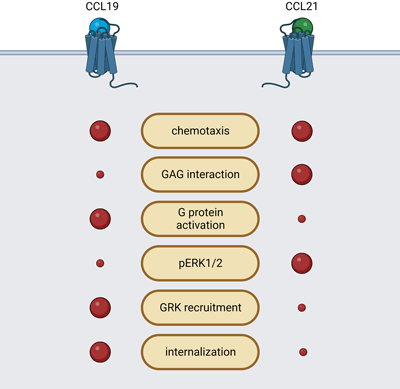Biased signaling
Chemokine receptors belong to the protein family of G protein-coupled receptors (GPCRs) that contain seven membrane-spanning helices. Certain chemokines have the property of being able to bind to several receptors. Conversely, a given receptor can also usually bind several different chemokines, here called ligands. The same is true for CCL19 and CCL21 with their common receptor CCR7. The two chemokines can send common or unique ligand-specific signals via CCR7 to different degrees and with different effects on cell behavior, depending on the cell type. This phenomenon is called "biased signaling".
CCL19 and CCL21 guide CCR7-expressing immune cells via the lymphatic pathways to draining lymph nodes. In the lymphatics, CCL21 is synthesized and immobilized at the endothelial cell surface by glycosaminoglycans (GAG), which are major components of the extracellular matrix. This prevents the chemokine from being flushed away by lymphatic flow. In contrast, CCL19 hardly interacts with glycosaminoglycans (Figure 1) and is considered soluble.

Figure 1: Biased signaling. As soon as the chemokine (CCL19 in light blue, CCL21 in green) binds to the chemokine receptor CCR7 (dark blue) on the cell surface, activation of the G protein occurs (G protein activation). Depending on the cell type, this triggers a variety of signals that vary in intensity and are represented here by the size of the red dots. For example, in certain cell types, CCR7 is transported to the interior of the cell, i.e., internalized (internalization), mainly after stimulation with CCL19 by a process called endocytosis. The figure shows further differential effects of receptor activation by the two ligands. These range from the interaction of the receptor with G protein-coupled receptor kinases (GRK recruitment) to the activation of signals from key molecules such as ERK1/2 (pERK1/2; phosphorylated ERK1/2), which play a role in the conversion of molecular signals into a genetic response, to the efficiency of cell migration (chemotaxis) or the interaction of chemokines with glycosaminoglycans (GAG interaction).
In recent years, we have been instrumental in advancing our understanding of not only the general but also the "biased signaling" activation pathway of CCR7. Our research also extended to post-translational modifications of CCR7 and their effects on receptor function, including ligand binding and chemotaxis. These findings, focused on pharmaceutical research, hold significant potential for the development of activators or inhibitors which could specifically target one signal transduction pathway without affecting others.
